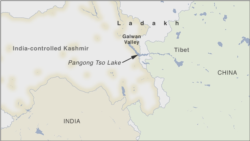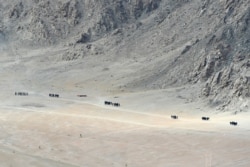India and China are pulling back troops from a disputed border in the Himalayas marking a key breakthrough in easing their worst military standoff in decades.
Indian Defense Minister Rajnath Singh told parliament Thursday that troops would begin disengaging from the strategic Pangong Tso lake in Ladakh that became a flashpoint between the Asian giants.
“Our sustained talks with China have led to agreement on disengagement on the north and south banks of the Pangong lake,” Singh said. He said the pact “envisages that both sides will cease their forward deployments in a phased, coordinated and verified manner."
The Indian statement follows an announcement by the Chinese Defense Ministry that both armies had begun “synchronized and organized disengagement” on the southern and northern shores of the lake.
The accord was reached after multiple rounds of military and diplomatic negotiations. The pullback from Pangong Tso Lake will be followed by disengagement from other areas, Singh said.
The standoff was sparked last May when India accused Chinese troops of coming deep into territory patrolled by Indian soldiers in the Pangong Tso lake area and erecting tents and guard posts. China said its troops were operating in its own area and accused Indian border guards of provocative actions.
The standoff intensified after 20 Indian soldiers were killed and several others were wounded in a brutal hand-to-hand combat when troops from both sides fought with crude weapons such as stones and clubs last June.
In the following months, both countries deployed tens of thousands of soldiers, fighter aircraft and heavy artillery along icy Himalayan slopes.
“Our aim is to maintain peace and tranquility at LAC [line of actual control]. Last year, what China did, impacted peace at the border,” Defense Minister Singh told parliament.
Large stretches of the roughly 3,800 kilometer-long India-China border in the Himalayas are disputed, with both sides claiming large swathes of each other’s territory. The boundary dispute has simmered since they fought a war in 1962 and negotiations have failed to resolve the issue. Following the tense standoff, both sides had bolstered forces all along the border.
Analysts in New Delhi have welcomed the disengagement but warn that the deep strain in ties caused by the months-long standoff is likely to persist.
“It was an important step and will hopefully build confidence,” says Harsh Pant director of studies at the Observer Research Foundation in New Delhi. “But we will continue to see greater volatility along the disputed border. The biggest challenge is that there is no trust now and that trust deficit will define future engagement.”
India, analysts say, will continue to build deeper ties with countries like the United States as it seeks to counter what it sees as a more aggressive China.
“If anything, this crisis with China has reinforced that India needs to leverage its partnership with like-minded countries like the U.S. much more robustly,” says Pant.
Earlier this week, in a telephone conversation, Indian Prime Minister Narendra Modi and U.S. President Joe Biden agreed to strengthen Indo-Pacific security through the Quad grouping that is seen as a way to push back against China’s growing assertiveness in the region. The Quad consists of India, United States, Japan and Australia.










